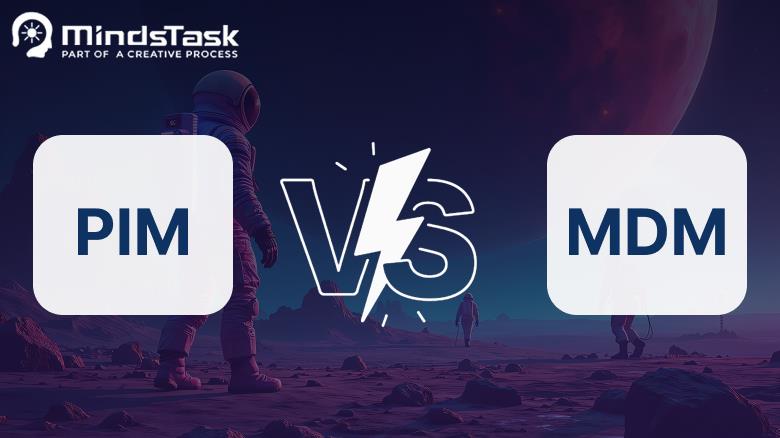A common dilemma for leadership teams developing a data strategy is determining how best to approach data governance and management. The optimal approach depends on the organization’s current pain points, data maturity, and growth objectives.
Managing vast amounts of data in today’s data-driven markets bring numerous challenges. Two solutions that consistently provide measurable Return on investment (ROI) are Product Information Management (PIM) and Master Data Management (MDM) systems. The strategic question, then, is which one to prioritize, and where to begin.
Let’s break down a decision framework to help navigate this choice.
The Decision Framework: PIM vs. MDM – Where to Start
The most effective way to approach this decision is to begin by identifying the core issue-
- If the organization is grappling with fragmented and inconsistent data across multiple departments, the issue likely is at the enterprise level- best addressed through an MDM initiative.
- Conversely, if the biggest obstacle is inconsistent, slow-to-market product information that affects digital channels and customer experience, a PIM solution may be the logical starting point.
PIM vs. MDM - Where to Start?
Determine whether the biggest obstacle lies in fragmented enterprise data or in inefficient product information.
Is the challenge- enterprise wide data chaos across multiple domains? Such as customers, suppliers, products, finance, etc. When different departments define the same entity differently, it creates operational waste in the form of duplicated effort, inconsistent reporting, and the absence of a single, trust source of truth.
Step 2A: Enterprise Data Chaos → MDM First
If your answer to Step 1 was “Yes,” then the organization likely suffers from fundamental data quality issues across various systems (ERP, CRM, PLM, SCM). You’re seeing:
- Duplicate, inconsistent, or missing records (e.g., the same SKU having different descriptions in different regions or systems).
- A desperate need for a "single source of truth" or "golden record" for critical data entities across all business units.
- Lack of clear data ownership and governance.
Recommendation: Implement MDM first.
MDM focuses on establishing data governance, defining data quality rules, and creating hierarchies for your master data. It’s about getting your foundational data in order. Once you have a clean, consistent master dataset (which includes product master data), you can then more effectively feed that reliable information into a PIM system for enrichment and channel syndication.
Step 2B: Product Experience Gap → PIM First
If your answer to Step 1 was “No,” then the primary issues are related specifically to product content. You might be experiencing:
- Time-to-market delays due to fragmented or manual product content management processes.
- Revenue impacts from inconsistent or poor-quality product data on your eCommerce site, marketplaces, or print catalogs.
- A need to manage rich digital assets (images, videos), detailed product descriptions, and channel-specific product data for an optimal customer experience.
Recommendation: Implement PIM first.
PIM systems are designed to centralize, enrich, and distribute product information and digital assets. They help you create compelling product experiences quickly and consistently across all your customer-facing channels. Once your product content is stellar and flowing smoothly, you can later connect with an MDM system if a broader need for multi-domain master data governance arises.
Related Blog: How to Implement a PIM System?
Both- Parallel implementation of PIM and MDM
Step 3: Parallel Approach Consideration
Sometimes, an organization faces both urgent eCommerce demands and deep-rooted enterprise-wide data challenges. In such cases, a parallel implementation approach can be viable—but only with careful planning and the right resources.
Consider this path if:
- The organization is simultaneously addressing time-sensitive eCommerce priorities and systemic data issues that cannot be deferred.
- There is sufficient budget, technical maturity, and strong executive alignment across departments.
- A capable architecture team is in place to define how PIM and MDM will coexist and integrate within the broader data ecosystem.
Recommendation: Run MDM and PIM in parallel. In this approach:
Phase 1 for MDM: Focus on defining data models, ownership, and foundational governance for your master data.
Phase 1 for PIM: Deploy PIM for quick wins in product syndication and enrichment, immediately improving customer experience.
Crucial Integration: Ensure clear integration points where MDM acts as the “golden record” for core product attributes, and PIM becomes the “experience layer” that takes this master data and enriches it with market-specific content and digital assets.
Key Takeaways
To simplify:
- MDM first → if the core problem is cross-domain data inconsistency & governance across the entire organization.
- PIM first → if the core problem is product experience, time-to-market, and eCommerce growth.
- Both parallel → if leadership, budget, IT maturity and urgency support a coordinated roadmap for tackling both foundational data and customer-facing product content simultaneously.
The Future is Integrated
Ultimately, PIM and MDM are not mutually exclusive. Many organizations find that they eventually need both. The question isn’t “PIM or MDM?” but rather “Which one do we need first to solve our most critical business problems, and how they integrate as the organization matures?”
By following this decision framework, you can strategically invest in the right solution at the right time, setting your organization up for greater efficiency, data accuracy, and a superior customer experience.

